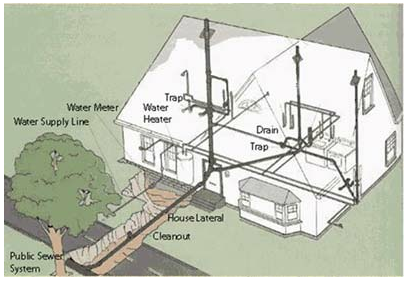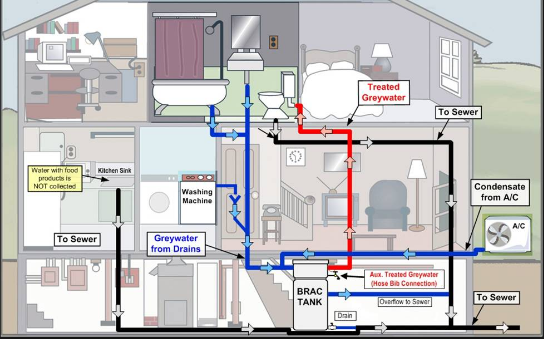What You Need to Know About Your House's Plumbing System Anatomy
What You Need to Know About Your House's Plumbing System Anatomy
Blog Article
Are you searching for help and advice concerning The Inner Workings of Your Home's Plumbing?

Understanding exactly how your home's pipes system works is vital for every single property owner. From providing clean water for alcohol consumption, cooking, and showering to safely eliminating wastewater, a properly maintained plumbing system is vital for your family's health and comfort. In this extensive overview, we'll discover the intricate network that comprises your home's pipes and offer ideas on maintenance, upgrades, and managing typical problems.
Introduction
Your home's pipes system is greater than simply a network of pipelines; it's an intricate system that ensures you have access to clean water and efficient wastewater removal. Recognizing its parts and how they interact can assist you prevent costly repairs and make sure every little thing runs smoothly.
Fundamental Parts of a Pipes System
Pipelines and Tubing
At the heart of your pipes system are the pipelines and tubing that carry water throughout your home. These can be constructed from numerous materials such as copper, PVC, or PEX, each with its benefits in regards to sturdiness and cost-effectiveness.
Components: Sinks, Toilets, Showers, etc.
Fixtures like sinks, bathrooms, showers, and bath tubs are where water is used in your home. Understanding exactly how these components attach to the plumbing system helps in detecting problems and preparing upgrades.
Shutoffs and Shut-off Factors
Shutoffs control the flow of water in your plumbing system. Shut-off shutoffs are critical during emergency situations or when you need to make repairs, enabling you to isolate parts of the system without disrupting water flow to the whole residence.
Water Supply System
Main Water Line
The main water line links your home to the local water system or an exclusive well. It's where water enters your home and is dispersed to numerous fixtures.
Water Meter and Pressure Regulatory Authority
The water meter actions your water use, while a stress regulatory authority ensures that water flows at a secure stress throughout your home's pipes system, protecting against damages to pipelines and components.
Cold Water vs. Warm water Lines
Recognizing the distinction between cold water lines, which supply water straight from the major, and hot water lines, which lug heated water from the water heater, aids in fixing and planning for upgrades.
Drainage System
Drain Pipes Water Lines and Traps
Drain pipes carry wastewater far from sinks, showers, and bathrooms to the sewer or septic tank. Catches prevent sewage system gases from entering your home and likewise trap debris that can cause obstructions.
Air flow Pipelines
Air flow pipelines enable air into the drainage system, preventing suction that might slow down drainage and create catches to empty. Correct ventilation is important for maintaining the honesty of your pipes system.
Value of Appropriate Drainage
Ensuring correct drain avoids back-ups and water damage. Frequently cleaning drains pipes and preserving catches can avoid costly fixings and prolong the life of your plumbing system.
Water Heating System
Sorts Of Water Heaters
Water heaters can be tankless or typical tank-style. Tankless heating units warmth water as needed, while containers keep heated water for instant use.
Just How Water Heaters Link to the Pipes System
Comprehending how hot water heater link to both the cold water supply and hot water circulation lines helps in detecting problems like insufficient warm water or leakages.
Maintenance Tips for Water Heaters
Regularly purging your water heater to get rid of sediment, checking the temperature level setups, and examining for leakages can extend its life-span and enhance power effectiveness.
Usual Plumbing Problems
Leakages and Their Causes
Leaks can take place due to maturing pipes, loosened fittings, or high water stress. Addressing leakages promptly stops water damage and mold growth.
Obstructions and Obstructions
Obstructions in drains and bathrooms are commonly caused by flushing non-flushable things or a buildup of oil and hair. Using drain displays and being mindful of what drops your drains can avoid obstructions.
Indicators of Pipes Problems to Expect
Low water stress, slow drains, foul odors, or abnormally high water expenses are indicators of potential plumbing issues that must be attended to quickly.
Plumbing Upkeep Tips
Regular Inspections and Checks
Arrange yearly pipes examinations to catch problems early. Seek signs of leaks, rust, or mineral buildup in faucets and showerheads.
Do It Yourself Upkeep Tasks
Basic tasks like cleansing faucet aerators, checking for commode leaks making use of color tablets, or insulating subjected pipelines in chilly environments can stop major pipes issues.
When to Call a Specialist Plumber
Know when a pipes concern calls for specialist knowledge. Trying intricate repair work without appropriate understanding can lead to more damage and higher repair work costs.
Upgrading Your Plumbing System
Reasons for Upgrading
Upgrading to water-efficient fixtures or replacing old pipes can improve water quality, reduce water expenses, and increase the worth of your home.
Modern Pipes Technologies and Their Advantages
Discover modern technologies like clever leak detectors, water-saving toilets, and energy-efficient water heaters that can save money and reduce ecological impact.
Cost Considerations and ROI
Calculate the ahead of time costs versus long-term savings when taking into consideration pipes upgrades. Lots of upgrades spend for themselves with lowered energy expenses and fewer repair work.
Environmental Influence and Preservation
Water-Saving Fixtures and Home Appliances
Installing low-flow faucets, showerheads, and toilets can considerably decrease water usage without compromising performance.
Tips for Decreasing Water Usage
Simple habits like fixing leaks promptly, taking shorter showers, and running complete lots of washing and recipes can preserve water and lower your energy costs.
Eco-Friendly Pipes Options
Think about sustainable plumbing products like bamboo for floor covering, which is durable and eco-friendly, or recycled glass for kitchen counters.
Emergency situation Preparedness
Steps to Take Throughout a Plumbing Emergency situation
Know where your shut-off shutoffs lie and exactly how to shut off the supply of water in case of a burst pipeline or significant leakage.
Significance of Having Emergency Contacts Useful
Keep get in touch with info for regional plumbing technicians or emergency services readily available for quick feedback during a pipes crisis.
Do It Yourself Emergency Fixes (When Relevant).
Short-lived repairs like utilizing duct tape to patch a dripping pipeline or placing a pail under a dripping tap can decrease damage until a professional plumbing professional gets here.
Final thought.
Recognizing the makeup of your home's plumbing system equips you to maintain it properly, saving money and time on repair services. By complying with normal maintenance routines and remaining informed regarding modern-day plumbing innovations, you can guarantee your pipes system operates successfully for several years to come.
HOW YOUR PLUMBING SYSTEM WORKS
Which Pipes Do What?
Blue lines = fresh water supply entering the building
Red lines = hot water supply entering the building
Grey lines = pipes carrying waste away from the building and venting pipes carrying gases away from the building (through the roof)
YOUR MAIN PLUMBING SYSTEMS
There are two main plumbing systems that support your home s basic plumbing needs one that brings clean water into your home, and one that sends dirty water away from your home. Connected to the toilet, bath, shower, and other faucets in your home, these two systems keep your water flowing in the right directions.
ACCESSING FRESH WATER
Fresh and clean water is brought into your home through the main water supply line . Filtered through one pipe, this water is pressured to flow into the various fixtures in your home at any given time.
This water can be sourced from a well located on your property, a pond or river (mostly cottages), or, as in most cases, from the city s municipal water treatment centre. However, it is important to note that water that is untreated, such as the water siphoned from ponds or rivers, may not be safe to drink. Personal water supplies always need to be treated for hardness and contaminants before consumed.
MUNICIPAL WATER SUPPLIES
Improve taste and odour
Remove sediment
Eliminate hardness
Reduce chlorine
COLD WATER SUPPLY VS. HOT WATER SUPPLY
Cold water flows into your home or building through the service line, which then distributes hot or cold water to your fixtures. This line is most commonly run through a central column that runs floor to floor. Hot water runs in short and straight pipes as the longer the pipeline, the more heat that will be lost in the transfer. Having shorter pipes also allows residents to access hot water more quickly.
WASTE WATER SYSTEM
Your wastewater system is divided into two parts pipes that send wastewater away from your home and venting pipes that send sewer gas away from your home. Sewage water travels through pipes that flush the water and waste towards local sewers that are operated and managed by your city or town. Most sewer systems rely on gravity to move the wastewater to where it needs to go.
The further away from your toilet or sink, the larger wastewater pipes become. This allows for waste to be disposed of from various parts of your home or business at once without pipe blockages. The angle and flow of these pipes are also essential for keeping your waste pipes clear of build up.
https://harrisplumbing.ca/how-your-home-plumbing-system-works/

HOW YOUR PLUMBING SYSTEM WORKS
Which Pipes Do What?
YOUR MAIN PLUMBING SYSTEMS
There are two main plumbing systems that support your home s basic plumbing needs one that brings clean water into your home, and one that sends dirty water away from your home. Connected to the toilet, bath, shower, and other faucets in your home, these two systems keep your water flowing in the right directions.
ACCESSING FRESH WATER
Fresh and clean water is brought into your home through the main water supply line . Filtered through one pipe, this water is pressured to flow into the various fixtures in your home at any given time.
This water can be sourced from a well located on your property, a pond or river (mostly cottages), or, as in most cases, from the city s municipal water treatment centre. However, it is important to note that water that is untreated, such as the water siphoned from ponds or rivers, may not be safe to drink. Personal water supplies always need to be treated for hardness and contaminants before consumed.
MUNICIPAL WATER SUPPLIES
COLD WATER SUPPLY VS. HOT WATER SUPPLY
Cold water flows into your home or building through the service line, which then distributes hot or cold water to your fixtures. This line is most commonly run through a central column that runs floor to floor. Hot water runs in short and straight pipes as the longer the pipeline, the more heat that will be lost in the transfer. Having shorter pipes also allows residents to access hot water more quickly.
WASTE WATER SYSTEM
Your wastewater system is divided into two parts pipes that send wastewater away from your home and venting pipes that send sewer gas away from your home. Sewage water travels through pipes that flush the water and waste towards local sewers that are operated and managed by your city or town. Most sewer systems rely on gravity to move the wastewater to where it needs to go.
The further away from your toilet or sink, the larger wastewater pipes become. This allows for waste to be disposed of from various parts of your home or business at once without pipe blockages. The angle and flow of these pipes are also essential for keeping your waste pipes clear of build up.
https://harrisplumbing.ca/how-your-home-plumbing-system-works/
I hope you liked our piece on Exploring Your Homes Plumbing Anatomy. Thanks a ton for spending some time to read our post. Enjoyed reading our write up? Please share it. Help another person locate it. Thanks a bunch for your time. Kindly check up our blog back soon.
Top Article Report this page